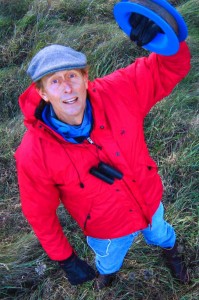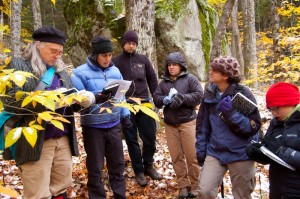
Tag: Google Earth
Beyond Prezi
Today I presented some preliminary results of a five-year winter wildlife tracking project my town’s conservation commission has just completed. I was part of a workshop on wildlife connectivity at the Vermont Statewide Conservation Conference in Rutland.
We had some spatial analysis and mapping of the tracking done by Kevin Behm at our county’s regional planning commission, and I wanted to display the mapped results in a compelling way. Google Earth was an obvious candidate for display, but driving Google Earth for a live audience is asking for trouble unless the show is simple. So I used the Movie Maker tool in Google Earth Pro to record three minutes of video highlighting the non-simple results and their context. Continue reading “Beyond Prezi”
A clipboard-free zone
After it warmed up a bit yesterday, I tried out my new digital field protocol on a wildlife tracking transect behind my house. My goal was to record the identity, quantity, and location of large animal tracks in the snow which crossed the path I was walking (my “transect”). I am trying to develop a protocol for purely digital collection of these data.
Three types of data must be collected: date, location, and observation. The date (and time) is easy because most digital data has a time stamp. Collecting location data requires a GPS enabled device. To collect the wildlife observation information in digital form requires manual data entry (keypad or touchscreen) or audio or video collection. I have seen some smart phone apps which could be bent to this purpose, but I don’t have such a phone, so the easiest route for me is audio, although this will require later translation to textual data.
[Update: I abandoned this three-device protocol after a few trials and now use only the GPS to make waypoints for each observation. The new method is described here.]
Linking the GPS data with the audio observations is the hard part. There are mature protocols for attaching GPS coordinates to image files, but not to audio files, although it should be easy to implement this on a smart phone. I used a digital photo as a link between the GPS data and the audio file. A key component of my protocol is a program which attaches GPS coordinates to photo files and can also associate an audio file with each photo. The program can also create a KMZ file or GIS shapefile which includes the georeferenced audio files. The program is RoboGeo which costs $80. This is the program that I use to georeference photos that I have taken while the GPS is recording a tracklog. Continue reading “A clipboard-free zone”
Roaring Brook

Ledge
I never heard the term “ledge” used as a synonym for bedrock before I moved to Vermont. But I once heard a guy in Maryland confirm it was bedrock by saying “Yeah, I think that’s a piece of the state.”
Here is a Google Earth KML file of two ledgey places I visited this week. One was made of Monkton quartzite with some dolomite strata and a rich, unusual plant community, and I accompanied some experts who identified three state endangered species. The other was made of Cheshire quartzite with somewhat less calcium available, and I recently found a lovely grove of pitch and red pines there. A new gigapan of that Pitch Pine-Oak-Heath-Rocky Summit community is included in the KML file.
You can see photos, GPS tracks, and the gigapan by downloading the KML file into Google Earth, or by clicking the link (below the break) to open it in a new browser window, or just use the embedded window at the bottom of the post (Your computer must have the Google Earth browser plugin installed). Continue reading “Ledge”
Gigapans in Google Earth KML tours
I have incorporated some gigapans into Google Earth KML tours and tried three ways to share the tours with others: embedding, KML preview, and downloading. There is not a clear winner. An earlier post has examples of all three methods.
A Google Earth KML (keyhole markup language) file can contain placemarks, paths, and polygons, but it can also include a tour in which recorded navigation movements (flying around) and an audio track can be played back. If a gigapan is included in a KML file which also includes a tour, the user can see where the gigapans are on the landscape and see previews of the gigapans. When the KML tour is stopped, clicking once on the gigapan icon (or the translucent panorama) opens a popup bubble with a thumbnail and the entire description from gigapan.org. Double clicking on the gigapan icon (or translucent panorama) flies you into the panorama just as the “View in Google Earth 4.2+” link at gigapan.org does. The recorded KML tour itself cannot include flying into a gigapan; that part does not seem to play back properly. Continue reading “Gigapans in Google Earth KML tours”
Town Forest KML tour
Below is an embedded Google Earth KML tour which introduces the relationship between the Salisbury Town Forest and some glacial features.
Below is an embedded Google Earth KML tour which introduces the relationship between the Salisbury Town Forest and some glacial features. It includes a two minute flying tour with audio narration. Your computer must have the Google Earth browser plugin installed to play the tour.
Click here to open the KML tour in a new browser tab. Then click the “Play Tour” button (upper right) to start the tour. Your computer must have the Google Earth browser plugin installed to play the tour. (Note: If you enter a gigapan, the “Exit Photo” button is partly hidden under the “Terrain” button. Click the exposed edge of it to exit the gigapan.)
The controls at the lower left of the tour window can be used to stop and start the tour, and when the tour is stopped you can navigate around the landscape and view the photos and gigapans. The links within the gigapan popups are not a good way to view the gigapans. Continue reading “Town Forest KML tour”
Kame terrace KML tour
Below is an embedded Google Earth KML tour which introduces some features of KML tours.
Below is an embedded Google Earth KML tour which introduces some features of KML tours. It includes a two minute flying tour with audio narration.
The controls at the lower left of the tour window can be used to stop and start the tour, and when the tour is stopped you can navigate around the landscape and view the photos and gigapans. The links within the gigapan popups are not a good way to view gigapans.
Click here to open the KML tour in a new browser tab. Then click the “Play Tour” button (upper right) to start the tour. (Note: If you enter a gigapan, the “Exit Photo” button is partly hidden under the “Terrain” button. Click the exposed edge of it to exit the gigapan.) Continue reading “Kame terrace KML tour”
Kame Terrace video
The 11.5 minute video below describes some geomorphological features at the eastern edge of the Champlain Valley in Vermont. It includes video animations made in Google Earth and saved as video files using the Movie Maker tool in Google Earth Pro. To watch in HD, go to Vimeo. Continue reading “Kame Terrace video”
Mount Abe Hike
The Google Earth KML tour below shows the hike Galen and I took on July 6, 2010 to the top of Mount Abraham in Vermont. The tour can be started and stopped using the controls at the lower left. The entire tour lasts 75 seconds and has no audio. When the tour ends, you can fly around the landscape, click on the photos to view them, and double click the Gigapan to fly into it. The links within the gigapan popup are not a good way to view the gigapan in an embedded tour.
Click here to open the KML tour in a new browser tab. Then click the “Play Tour” button (upper right) to start the tour. (Note: If you enter a gigapan, the “Exit Photo” button is partly hidden under the “Terrain” button. Click the exposed edge of it to exit the gigapan.) Continue reading “Mount Abe Hike”
